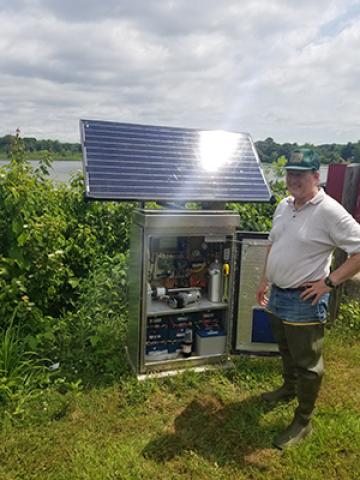Determining Where CO2 Comes from May Dictate Mitigation Efforts

Gregory W. McCarty, ARS soil scientist at the Hydrology and Remote Sensing Laboratory in Beltsville, MD, checks equipment that measures carbon in the water of the Tuckahoe Creek Watershed on Maryland’s Eastern Shore. (Photo courtesy of Xuesong Zhang)
Most people know that greenhouse gasses (GHG) affect the environment, and that burning fossil fuel is the primary source of carbon dioxide (CO2) GHGs. What many people don’t realize, however, is that inland water – which covers less than 2% of the Earth’s surface and includes streams, rivers, wetlands, and lakes – pumps even more CO2 into the atmosphere than land.
Since 2009, scientists with the Agricultural Research Service (ARS) have been developing the Terrestrial and Aquatic Sciences Convergence (TASC) model, which can measure how much CO2 inland waters generate.
TASC is an improvement of the Soil & Water Assessment Tool (SWAT) model, which is a small watershed to river basin-scale model that simulates the quality and quantity of surface and ground water and predicts the environmental impact of land use, land management practices, and climate change. SWAT is widely used to assess soil erosion prevention and control, non-point source pollution control, and regional management in watersheds.
TASC is capable of measuring both terrestrial and aquatic carbon cycles at the watershed scale. Knowing how much carbon is contained in soils and how much carbon is transported from land to and emitted from inland waters is critical to the fight against climate change.
For instance, according to Xuesong Zhang, physical scientist with the ARS Hydrology and Remote Sensing Laboratory in Beltsville, MD, recent studies show that global CO2 emissions from inland waters to the atmosphere could be as high as 14.3 billion metric tons (each metric ton weighs 2,205 pounds), compared to 9.2 billion metric tons from ocean uptake (the amount of CO2 the oceans absorb from the atmosphere as its own carbon sink) and 12.5 billion metric tons from land-based carbon sinks.
“Sustainable agricultural management, such as conservation tillage, cover cropping, and efficient nutrient management, holds promise to cut 3 billion metric tons of CO2 emissions,” Zhang said. “However, current carbon accounting methods do not consider the CO2 sources and sinks in aquatic ecosystems, which represent a significant uncertainty in effective management of CO2 emissions of agroecosystems.”
In short, there must be accounting for the carbon cycle in aquatic environments. Without it, current estimates of the carbon sequestration benefits of agriculture conservation and biofuel production are subject to significant uncertainty, Zhang said. “This could lead to the failure of our climate mitigation goals.”
Current adoption of smart agricultural practices, such as growing cover crops, tilling the land less, and using fertilizer and irrigation more efficiently, can either soak large amounts of carbon from the atmosphere into soils or emit less CO2 into the atmosphere. When running on a computer, the TASC model functions like a digital twin of the watersheds in the real world and allows researchers to explore various possible scenarios to identify the best practices to achieve goals.
“For example, you can identify a parcel of land on a map and assume a cover crop is grown there. The TASC model can tell you how much carbon can be sequestered and stored in the soils of that parcel of land. It can also tell you to what extent the growth of the cover crop can reduce soil erosion and carbon, nitrogen, and phosphorus loss to the rivers and coastal waters,” he explained. “Such information can support smart actions over a large region, such as the Chesapeake Bay watershed.”
USDA’s sustainability goals include increasing agricultural production while dramatically reducing its environmental footprint. To achieve these goals simultaneously, avoiding inadvertent negative consequences, Zhang noted that, “We need a tool that allows us to simultaneously assess a range of social-environmental impacts.”
Zhang has been leading the TASC project since 2009 and has received research support from NASA, EPA, the U.S. Department of Energy, and the National Science Foundation. He also works with USDA’s Natural Resources Conservation Service to plan future USDA models and field experiments to integrate both terrestrial and aquatic carbon cycles.
“The challenge of linking terrestrial and aquatic carbon cycling is a world-class challenge for effective climate mitigation and the challenge is increasingly recognized across the globe,” he said. – by Scott Elliott, ARS Office of Communications

